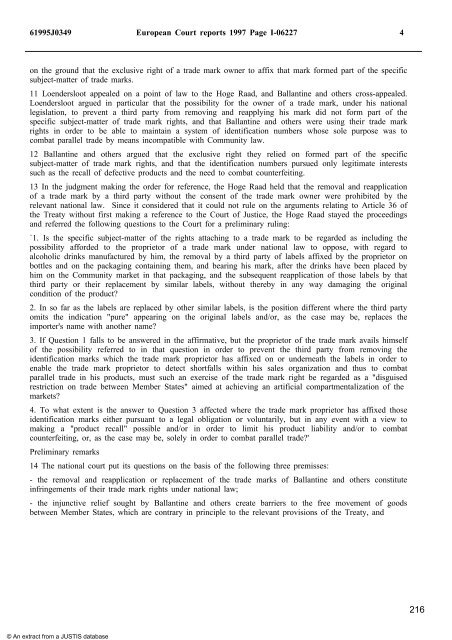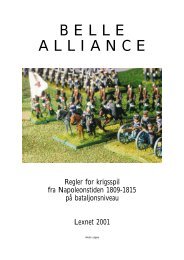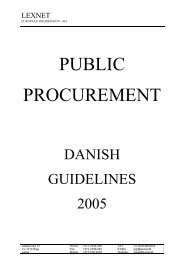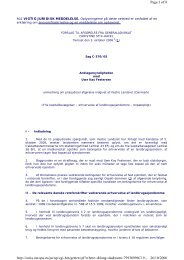Master's Program 2004/2005 Technical and Fiscal Barriers ... - Lexnet
Master's Program 2004/2005 Technical and Fiscal Barriers ... - Lexnet
Master's Program 2004/2005 Technical and Fiscal Barriers ... - Lexnet
You also want an ePaper? Increase the reach of your titles
YUMPU automatically turns print PDFs into web optimized ePapers that Google loves.
61995J0349 European Court reports 1997 Page I-06227 4<br />
on the ground that the exclusive right of a trade mark owner to affix that mark formed part of the specific<br />
subject-matter of trade marks.<br />
11 Loendersloot appealed on a point of law to the Hoge Raad, <strong>and</strong> Ballantine <strong>and</strong> others cross-appealed.<br />
Loendersloot argued in particular that the possibility for the owner of a trade mark, under his national<br />
legislation, to prevent a third party from removing <strong>and</strong> reapplying his mark did not form part of the<br />
specific subject-matter of trade mark rights, <strong>and</strong> that Ballantine <strong>and</strong> others were using their trade mark<br />
rights in order to be able to maintain a system of identification numbers whose sole purpose was to<br />
combat parallel trade by means incompatible with Community law.<br />
12 Ballantine <strong>and</strong> others argued that the exclusive right they relied on formed part of the specific<br />
subject-matter of trade mark rights, <strong>and</strong> that the identification numbers pursued only legitimate interests<br />
such as the recall of defective products <strong>and</strong> the need to combat counterfeiting.<br />
13 In the judgment making the order for reference, the Hoge Raad held that the removal <strong>and</strong> reapplication<br />
of a trade mark by a third party without the consent of the trade mark owner were prohibited by the<br />
relevant national law. Since it considered that it could not rule on the arguments relating to Article 36 of<br />
the Treaty without first making a reference to the Court of Justice, the Hoge Raad stayed the proceedings<br />
<strong>and</strong> referred the following questions to the Court for a preliminary ruling:<br />
`1. Is the specific subject-matter of the rights attaching to a trade mark to be regarded as including the<br />
possibility afforded to the proprietor of a trade mark under national law to oppose, with regard to<br />
alcoholic drinks manufactured by him, the removal by a third party of labels affixed by the proprietor on<br />
bottles <strong>and</strong> on the packaging containing them, <strong>and</strong> bearing his mark, after the drinks have been placed by<br />
him on the Community market in that packaging, <strong>and</strong> the subsequent reapplication of those labels by that<br />
third party or their replacement by similar labels, without thereby in any way damaging the original<br />
condition of the product?<br />
2. In so far as the labels are replaced by other similar labels, is the position different where the third party<br />
omits the indication "pure" appearing on the original labels <strong>and</strong>/or, as the case may be, replaces the<br />
importer's name with another name?<br />
3. If Question 1 falls to be answered in the affirmative, but the proprietor of the trade mark avails himself<br />
of the possibility referred to in that question in order to prevent the third party from removing the<br />
identification marks which the trade mark proprietor has affixed on or underneath the labels in order to<br />
enable the trade mark proprietor to detect shortfalls within his sales organization <strong>and</strong> thus to combat<br />
parallel trade in his products, must such an exercise of the trade mark right be regarded as a "disguised<br />
restriction on trade between Member States" aimed at achieving an artificial compartmentalization of the<br />
markets?<br />
4. To what extent is the answer to Question 3 affected where the trade mark proprietor has affixed those<br />
identification marks either pursuant to a legal obligation or voluntarily, but in any event with a view to<br />
making a "product recall" possible <strong>and</strong>/or in order to limit his product liability <strong>and</strong>/or to combat<br />
counterfeiting, or, as the case may be, solely in order to combat parallel trade?'<br />
Preliminary remarks<br />
14 The national court put its questions on the basis of the following three premisses:<br />
- the removal <strong>and</strong> reapplication or replacement of the trade marks of Ballantine <strong>and</strong> others constitute<br />
infringements of their trade mark rights under national law;<br />
- the injunctive relief sought by Ballantine <strong>and</strong> others create barriers to the free movement of goods<br />
between Member States, which are contrary in principle to the relevant provisions of the Treaty, <strong>and</strong><br />
© An extract from a JUSTIS database<br />
216







